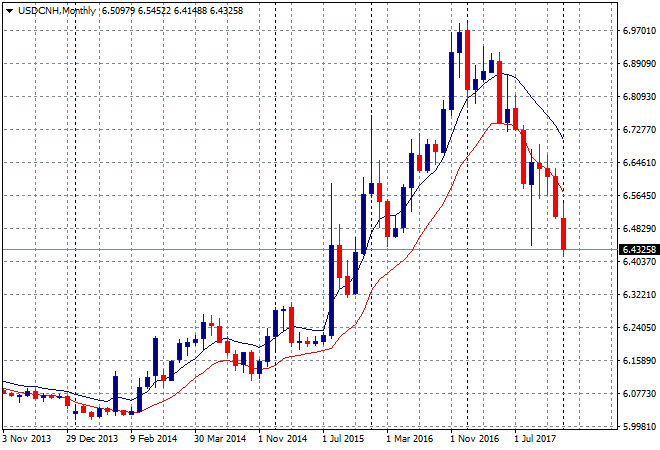While the headlines surround the trajectory of the Australian dollar versus the USD, it’s the Yuan making the rounds as it hits a new two year high. From SCMP:
On Monday, the People’s Bank of China (PBOC) lifted the daily yuan reference rate by 0.55 per cent to 6.4570 per dollar, in its biggest daily move since October.
The currency’s reference rate is used as a mid-point, allowing trades of up to 2 per cent on either side of the so-called fix for the day.
The PBOC’s recent decision to remove the counter cyclical factor from the formula to calculate the daily yuan fixing allowed higher two-way volatility in the exchange rate and amplified the strong euro impact on the yuan, said Ken Cheung, senior Asian FX strategist at Mizuho Bank.
“Under this circumstance, the yuan should maintain its upside momentum if the euro refuses to retreat,” Cheung said.
There has been a significant reversal in how the PBOC has managed the currency as it aligns more and more with the reality of the USD decline:
It’s not just the USD however, as the Yuan strengthens against most of the majors in the RMB Index:

Last night the German Bundesbank decided to include the Yuan in its currency reserves, which will most likely push the RMB Index higher and place more pressure on the daily USDCNH fix.
From Bloomberg:
Bundesbank board member Andreas Dombret said the decision was taken last year following an investment of 500 million euros ($611 million) by the European Central Bank, of which the German authority is a part. He said he wouldn’t comment on the amount that would be allocated.
“The renminbi is used increasingly as part of central banks’ foreign-exchange reserves — for example, the ECB included the RMB but also other European central banks did so,” Dombret said during a speech in Hong Kong Monday.
This is part of a multi tiered approach by Chinese authorities to push its currency globally, squeezing USD influence along the way.
Part of that process is likely to be a floating instead of the current fixed arrangement, but China has a long way to go to ensuring its exchanges and trading systems are robust and transparent enough to allow such a big move.
The next test is how it handles the coming China slowdown. By rights, any further stimulus should see a return to outflows.
Longer term, one wonders how long before MB is forced to track the global redback daily.
